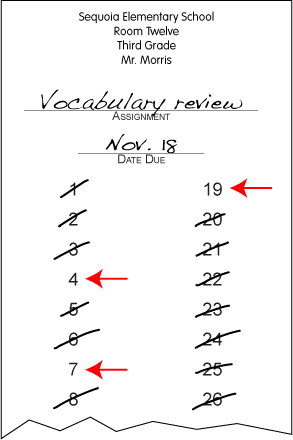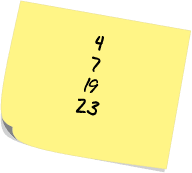
Clothespin Check Off List
The basic Check Off List, as explained in the New Management Handbook, is nothing more than a slip of paper. At the top is a place for the teacher to write the name of the assignment being collected and the date it is due. Below the header, in two columns, are student numbers.
As a student completes an assignment, he places it in a collection box--the lid to a case of xerox paper works great--and marks off his number. As the deadline for the assignment draws near, the teacher only needs to take a quick glance at the unmarked numbers to know which students have yet to complete and turn in the assignment.

The Joy of Certainty
At the deadline, the entire stack of assignments is given to a student who quickly collates the papers from lowest number to highest. When finished, the collator will stick a post-it on the top paper that lists the numbers of the students who did not turn in the assignment. Consequently, if the post-it for the sample above looked like...

...the teacher would know that Patrick, student number 23, did not complete the work and is need of a private chat.
And that's the beauty of numbers. A student who hadn't completed the assignment can't just mark off his number in an attempt to avoid detection. The certainty of numerical order makes it easy to figure out who finished and who didn't.
Here's the introduction from the chapter on using a Check Off List that can be found in the New Management Handbook:
With the introduction of the Check Off List, the power of student numbers takes a major leap forward. The Check Off List was the first New Management tool that convinced me that student numbers was going to be the foundation upon which I was going to build a system of classroom organization and management.
Over the years, the Check Off List (COL) has proven itself to be a powerful tool for reinforcing the basic tenets of the New Management philosophy. Here's the action to back up my words. Here's the muscle behind my smile. It's both simple and efficient. It empowers me to stay calm, which does wonders for the overall sense of control I am able to maintain. And, as a direct result of these factors, my stress is reduced.
For the students, the Check Off List helps them in developing a sense of accountability and ownership. They end up spending more of their time completing assignments and activities and less time trying to figure out how to get out of them.
The Check Off List is Mr. Do Everything. If you need something taken care of, the COL is your guy. This wonderfully versatile tool will keep track of just about anything your students need to complete.
So, basically, the Check Off List is one of the simplest, yet most powerful tools for taking advantage of student numbers.
However, the opportunities for using a Check Off List for collecting assignments should not be limited to a flat, static, two-dimensional piece of paper. Although the paper model works quite well, there is a wealth of alternative media available just waiting to be used.
Beyond a Paper List
One such option consists of a set of numbered clothespins and a box lid. Wooden clothespins, that have been numbered on both sides, are placed around the lip of the box. As a student places his assignment in the box, he removes his clothespin and puts it in a small container that sits next to the box. Just like the original paper COL, you'll be able to see who's finished and who's not. Piece of cake.

![]()
Advantages
There are two advantages to using manipulatives for collection tools.
One is that it's more fun for the students. And fun, as I think everyone knows by now, is one of the five basic student needs identified by Bill Glasser as being critical to a student's success and achievement.
Another advantage is that a student will be able to reset the tool for you so that it is ready for the next day. It's these kinds of student-run operations that really help the teacher build those all-important relationships with their students.
This is especially true for the under-achievers in the room who are sometimes excluded from "helping the teacher" activities. With student numbers, anyone can help because of the simple structure numbers provide. High achiever, low achiever, extrovert, introvert, passive, and even aggressive students--who learn to channel their negative feelings in a positive direction--can participate in the basic business of running a successful classroom.
Bonus: Not only will a student be able to reset the clothespins for the next time it's needed, he'll eventually become an assistant teacher as he begins to check with students who have yet to turn in the assignment.
![]()
Kaizen (The Japanese principle of continuous improvement)
As opposed to the students dropping their clothespins in a box next to the lid, I've learned that dropping them into a coffee can has an added advantage: sound.
The little "pling" sound that the first few clothespins make as they're dropped into the can sends out a clear message to the entire class that another student has finished the assignment. There's nothing like a little auditory feedback loop for encouraging the plodders to pick up the pace.
![]()
Photos
Here are a few shots of this idea being used in my room.

Here's a shot I took in another teacher's classroom that shows the clothespins clipped to a little bucket. Very nice.

If you'd like to add your own photos to this post, just send 'em to me.
![]()
Beyond a Paper List, Take Two
If you haven't checked out the magnetic tiles I made using some polygons from the Mathland kit, you should do so. Although identical in principle to this week's idea--the use of numbered manipulatives for student accountability--the tiles have a couple of advantages.
For one, the bright yellow tiles really stand out on a whiteboard. As you can see below, students 7, 11, and 15 have yet to finish. This makes it easy to assess completion progress from anywhere in the classroom.

Another advantage is the freedom to create more categories than the basic "finished" and "not yet finished" spaces shown above. This alone opens the door to all kinds of possibilities.
One simple idea would be to create a third area on the whiteboard for students who, when finished, were willing to tutor. For a student struggling to complete the assignment on his own, the tiles in the "tutor" area would make it easier to seek help. And the freedom to choose which student to ask for help would make it more likely that help would be sought in the first place.
Bottom line: You'd not only have more students helping their classmates but more students being able to complete assignments on time. Win-Win.
![]()

